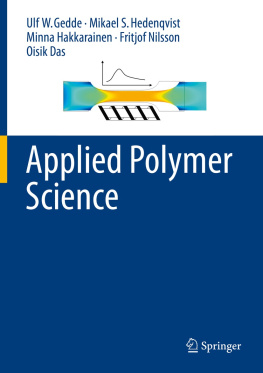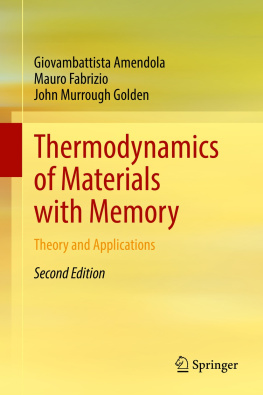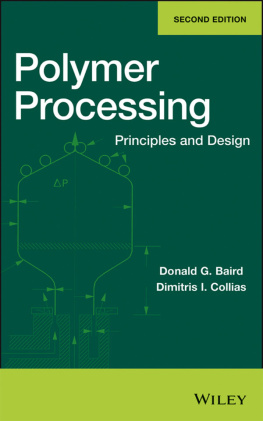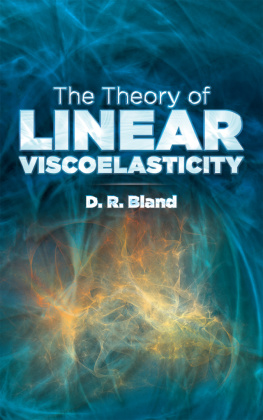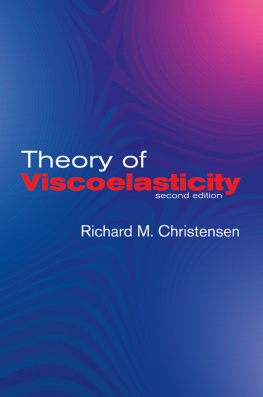Table of Contents
List of Tables
- Chapter 2
- Chapter 3
- Chapter 4
- Chapter 5
- Chapter 6
- Chapter 7
List of Illustrations
- Chapter 1
- Chapter 2
- Chapter 3
- Chapter 4
- Chapter 5
- Chapter 6
- Chapter 7
Guide
Pages
Introduction to Polymer Viscoelasticity
Fourth Edition
Montgomery T. Shaw
William J. MacKnight
Copyright
This fourth edition first published 2018
2018 JohnWiley & Sons, Inc
Edition History
Third Edition: 2005, Copyright John Wiley & Sons, inc.
All rights reserved. No part of this publication may be reproduced, stored in a retrieval system, or transmitted, in any form or by any means, electronic, mechanical, photocopying, recording or otherwise, except as permitted by law. Advice on how to obtain permission to reuse material from this title is available at http://www.wiley.com/go/permissions.
The right of Montgomery T. Shaw and William J. MacKnight to be identified as the authors of this work has been asserted in accordance with law.
Registered Office
John Wiley & Sons, Inc., 111 River Street, Hoboken, NJ 07030, USA
Editorial Office
111 River Street, Hoboken, NJ 07030, USA
For details of our global editorial offices, customer services, and more information about Wiley products visit us at www.wiley.com.
Wiley also publishes its books in a variety of electronic formats and by printondemand. Some content that appears in standard print versions of this book may not be available in other formats.
Limit of Liability/Disclaimer of Warranty
In view of ongoing research, equipment modifications, changes in governmental regulations, and the constant flow of information relating to the use of experimental reagents, equipment, and devices, the reader is urged to review and evaluate the information provided in the package insert or instructions for each chemical, piece of equipment, reagent, or device for, among other things, any changes in the instructions or indication of usage and for added warnings and precautions. While the publisher and authors have used their best efforts in preparing this work, they make no representations or warranties with respect to the accuracy or completeness of the contents of this work and specifically disclaim all warranties, including without limitation any implied warranties of merchantability or fitness for a particular purpose. No warranty may be created or extended by sales representatives, written sales materials or promotional statements for this work. The fact that an organization, website, or product is referred to in this work as a citation and/or potential source of further information does not mean that the publisher and authors endorse the information or services the organization, website, or product may provide or recommendations it may make. This work is sold with the understanding that the publisher is not engaged in rendering professional services. The advice and strategies contained herein may not be suitable for your situation. You should consult with a specialist where appropriate. Further, readers should be aware that websites listed in this work may have changed or disappeared between when this work was written and when it is read. Neither the publisher nor authors shall be liable for any loss of profit or any other commercial damages, including but not limited to special, incidental, consequential, or other damages.
Library of Congress CataloginginPublication Data
Names: Shaw, Montgomery T., author.
Title: Introduction to polymer viscoelasticity / Montgomery T. Shaw, William
J. MacKnight.
Description: Fourth edition. | Hoboken, NJ, USA : Wiley, 2018. | Original
1972 edition by John J. Aklonis, William J. MacKnight, and Mitchel Shen |
Includes bibliographical references and indexes. |
Identifiers: LCCN 2017058166 (print) | LCCN 2017059024 (ebook) | ISBN
9781119181811 (pdf) | ISBN 9781119181828 (epub) | ISBN 9781119181804
(cloth)
Subjects: LCSH: Polymers. | Viscoelasticity.
Classification: LCC TA455.P58 (ebook) | LCC TA455.P58 A35 2018 (print) | DDC
620.1/9204232dc23
LC record available at https://lccn.loc.gov/2017058166
Cover Design: Wiley
Cover Image: stellalevi/Gettyimages
Dedication
To A. V. Tobolsky, who first introduced us to the mysteries of polymer viscoelasticity and to the art of scientific research
Preface to the Fourth Edition
For the last dozen years, the 3rd Edition of Introduction to Polymer Viscoelasticity has served well. During this time, the authors have received many constructive suggestions from students and instructors, including conflicting ones such as simplify; it's a bit too complicated paired with expand the theoretical parts. In response to these and other comments, rather modest goals were set for the 4th Edition, namely
- Correct all known errors reported by many kind readers. Errors fall into two categories: (1) the usual grammatical slips and (2) serious mistakes such as equations with missing parts and poorly posed problems. Indeed, one problem was found that we could not solve, and obviously didn't belong in an introductory text. It has been removed.
- Provide more unanswered problems. Since the birth of this text in the early 1970s, answers have been provided for many of the chapterend problems. The reason for this is these problems typically review fundamental concepts, serving as additional solved examples. Some introduce new concepts. However, most instructors want unsolved problems that can be assigned as homework, adapted for active learning exercises and short projects, or used for tests or quizzes.
- Introduce the fields of microrheology and largeamplitude oscillatory strain (LAOS). The former attempts to examine dynamics around very tiny particles, including molecules, to gain information about the local environment, while the latter pushes the material hard enough to cause structural changes. LAOS is particularly important for complex materials where the concepts of structural strength and healing are of significant practical importance. Professors Eric Furst and Randy Ewoldt provided valuable advice on these sections, respectively.
- Open the very large topic of biopolymer viscoelasticity. There is no end to the examples that could be chosen, so we settled on some very different polymers: wood at the highmodulus extreme and hydrogels for the lowmodulus extreme. Guidance for this section from Professor Kelly Burke is gratefully acknowledged.
- Provide an Instructor's Guide with detailed answers to problems presented in the text. The answers are much more than a key for grading homework, in that they provide guidance for what to say to the students who are having trouble approaching a problem solution. Nearly 80 new problems were added, including a selection of problems that do not appear in the text.
Items we have resisted including in this introductory text are tensorial representation of stress and strain, viscoelastic properties and analysis of composite materials (with wood being an exception), selfstructured materials such as liquid crystals and block copolymers with longrange order, and the more baffling characterization methods and analyses such as transform, multiwave, and sonic methods. As the general level of student training and understanding increases, such topics may become more appropriate for an introductory text.


